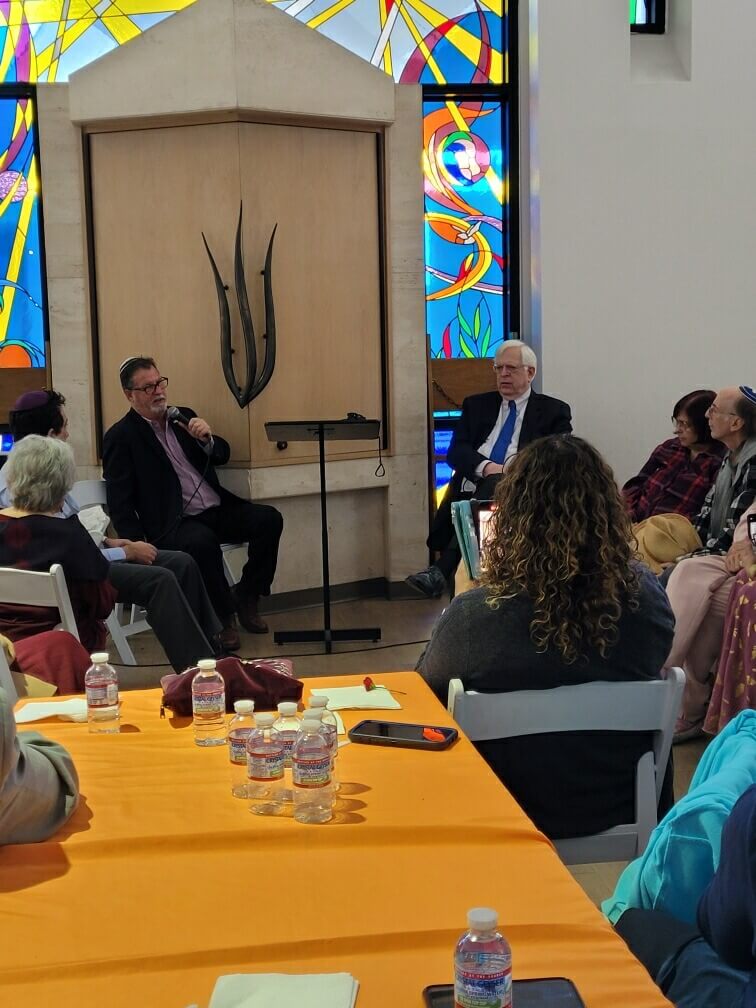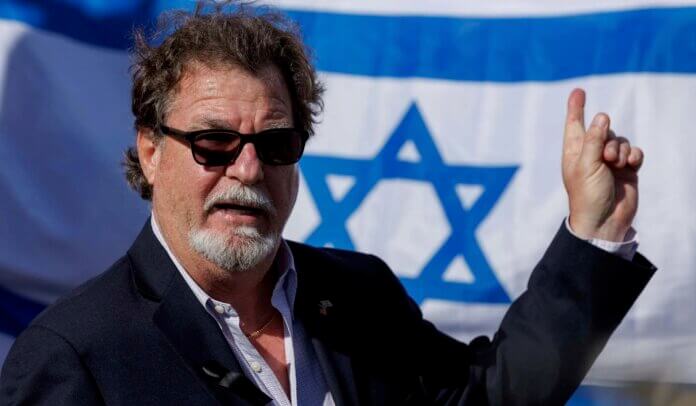Jonathan Oswaks and Paul Kessler, both 69, occupied opposite ends of the political spectrum but shared a passion for Israel and a desire to stand for their country locally — a choice that led to the death of one and a spiritual rebirth for the other.
“It’s been a life-altering experience,” Oswaks told The Conejo Guardian in an interview.
The unlikely pair knew each other for just two weeks, meeting through Next Door in late October, where Oswaks (pronounced OSS-wax) was advertising to see if anyone wanted to join him for pro-Israel counter-protests in Thousand Oaks.
“Paul responded positively to that,” says Oswaks, who has lived in the Conejo Valley since 2002 and raised three girls who attended public schools.

The two met in person for the first time at the intersection of Westlake Boulevard and Thousand Oaks Boulevard on Oct. 29 at a rally that had “a very scary, out of control feeling to it,” Oswaks says.
“It was a large contingent of young women,” he says. “There were a couple of men there, older men — like the imam from the mosque and this realtor-guy and a senior scientist at Amgen — but they were using the women as their foil. I was like, this just feels weird to have all these girls shouting at you with megaphones.”
Even “normal people” supporting the cause were being “whipped up into a frenzy,” he says. That day, a man flashed a gun at him and pushed him into traffic, and college-age women repeatedly put a bullhorn in Kessler’s face and yelled, “Hitler should have ended you! Hitler should have smashed you!” Oswaks says.
“After what happened on the 29th, Paul and I saw we need to come back with numbers if we want to be seen,” Oswaks says. “I said, let me see what I can do to raise people up on Next Door.”
But Oswaks’ post on Next Door — which he describes as a “Hey, Jews of the 805, kind of thing, we can’t let this happen in our community. Come stand up” — was removed for violating community standards. It surprised him, but “I’ve never done anything like this before,” he says.
On Nov. 5, the pro-Israel contingent numbered just Oswaks, Kessler and a couple of people Kessler had recruited.
“I figured, well, we’ll just go and see what happens,” Oswaks says. “Pretty naive on my part.”
The two new friends met an hour before the scheduled 3 o’clock event, sitting on a bench near the fountain by Paul Martin’s restaurant. Two other men — Loay Abdel Fattah Alnaji, 50, a Jordanian citizen later charged with manslaughter in Kessler’s death, and an Arab man whom Oswaks says is a senior scientist at Amgen — sat at a nearby bench.
“Paul says to me, ‘Hey, we’re being watched. They’re taking video of us,’” Oswaks remembers. “You could see Alnaji and this other guy, the Amgen guy, sitting there. Alnaji’s using his camera. I was like, I don’t give a **** if they’re taking video of us.”
Then, the two 69-year-old Jews got acquainted.
“I told him who I was, what I did for a living and even what my political affiliation is, and he said, ‘Yeah, we’re not going to align on that,’ but that was okay with me,” Oswaks says. “I’ve had friends who I have coffee with who are libs, and we live to see each other another day.”
Kessler shared what he did for a living and that he had recently retired from Welch Allyn, a medical diagnostic device maker for whom Oswaks, a mechanical engineer, had also worked.
“We laughed about that, that we never met that way, but here we are meeting this way,” he says.
“It’s been a life-altering experience.”
Jonathan Oswaks
Then Oswaks told him he hadn’t been in a temple for 23 years, but that after the counter-protest the week before, he attended a Friday night service on Nov. 3 at Temple Etz Chaim on Janss Rd. Kessler mentioned that his wife used to be on the board there, then asked a question: “Why’d you go?”
Oswaks replied, “I don’t know, but the rabbi asked me the same thing.”
After chatting some more, at about 2:20 p.m., they walked to the Shell station, got flags from a friend, and prepared to take up their posts on separate corners for greater visibility. Kessler, who was smaller in stature, insisted on holding the Israeli flag, Oswaks says.
“I said, ‘You should give me the Israeli flag because that’s the one that’s going to get the most trouble.’ He said, ‘No, I want the Israeli flag,’” Oswaks says. “It’s the target flag. These people hate Jews. I knew that that flag was going to be problematic. I said, ‘I think I should hold that flag,’ and he wasn’t having it.”
Bearing the Gadsden flag and an American flag, Oswaks crossed to the northeast corner of the intersection and prepared to stand his ground. Before he did, he told Kessler, “You need to hold the flag high so I can spot you.” Kessler did just that.
By now, anti-Israel protesters had wheeled out a generator and sound system through which they shouted, “Allahu akbar,” and led various chants which were taken up by participants, some with megaphones. The chants included, “From the river to the sea,” “Joe Biden, you can’t hide, we charge you with genocide,” and, “Hitler should have smashed you. Hitler should have killed you. You’ll burn in hell; you’ll see,” Oswaks says. He told the megaphone-yellers behind him to give him some space, and Alnaji briefly engaged him in a strange way, saying, “You look thirsty. You’ve been out here a while. Can I get you some water?” Oswaks told him instead that he wanted Alnaji and his companion to leave, which they did, crossing to where Kessler was in front of the Shell station.
Not long after that, Oswaks saw a megaphone moving rapidly through the air at that corner, followed by commotion amidst the ever-present yelling of anti-Israel slogans. Sticking to his ground on the corner, he asked someone nearby what had happened and was told, “Some old lady fell.” The person on the ground was not visible for the crowd around him, and in a coincidence, another protest participant was wearing a nearly identical shirt to Kessler’s and a similar-looking hat. Assuming the fallen person was a friend Kessler had brought, Oswaks watched from a distance as police, then fire engines, and then an ambulance arrived and took someone away.
Some minutes later, Oswaks walked to the Shell station corner and learned Kessler had gone in the ambulance, but Oswaks assumed it was to accompany an injured friend. The Israeli flag was leaning against a wall. Then someone pointed to the blood on the sidewalk and said, “That’s your friend Paul’s blood. He’s in the ambulance.”
Oswaks immediately said, “Oh. I’ve got to go. I’ve got to go over to Los Robles.”
He did so, running into the emergency room and asking to see Paul, whose last name he did not know. A nurse told him Paul was there, and sheriffs were meeting with him, but after more than half an hour, nobody came to see Oswaks. He left his contact information for the sheriffs and left but didn’t hear anything.
The next morning, on his way to coffee, he diverted from his usual course to drive by the Shell station and saw a large, white trailer there and tripods set up on the streets bearing big, white globes. Pulling in, he asked a sheriff about Kessler’s medical status but was told they were not at liberty to discuss it.
At that moment, Oswaks received a text from a friend asking, “What happened to the guy that was injured yesterday?” Oswaks replied, “He’s still in Los Robles.” Within a minute, the same person sent a follow-up message: “OMG, I got this message now. I was hoping it’s fake.” It was a report saying Kessler had died.
“I had this cold, empty feeling because there’s a big difference between somebody getting hit in the head and they have a concussion and are sitting in a hospital, and knowing they died of the injury and that I was the one that recruited him,” Oswaks says. “I still feel that way. … I have never felt anything like that before.”
He immediately went over to the temple, and the rabbi he’d met days earlier came out and recognized him right away. He walked over to Oswaks and said, “Now we know why you’re here, huh.”
Since the loss of Kessler, Oswaks has attended multiple Jewish services each week.
“Tomorrow morning, I’ll go to temple in Granada Hills, and I’m going to a Chabad, which is more traditional,” he says. “I had never put on tefillin. I can tell you this: everything that’s happened to me since then is something new that I am not in control of. I actually believe that I’m being guided right now.”
He says he admired Kessler for not being afraid to speak his mind. He and others organized a vigil for Kessler at the Shell station on Nov. 12, and Oswaks traveled to Washington, D.C., with state senator Henry Stern to meet with elected leaders from California to discuss the incident.
“People are scared,” he says of the Jewish community. “People are out buying guns. People have concerns that these kinds of things can go unchecked in our community.”
Oswaks has spoken to every local news station and several national media but still feels he has not had time to properly grieve for the man he was just getting to know.
“There’s just so many different emotions running through my veins,” he says. “The first one for me, to be honest with you, is anger. I’m angry. I want somebody’s head for this. Every time I see this on TV — it’s happening all over the world. I witnessed it happening in Washington, D.C., when I went the following week when pro-Palestinian protesters broke into the DNC [Democratic National Committee headquarters]. It’s anarchy. It’s mob rule.”
But for now, Oswaks is speaking as he has opportunity — as he did with Dennis Prager recently and with other media — deciding how to spend the rest of his retirement years and connecting with the faith he had given up for much of his adult life — but which now seems more alive in the wake of the loss of a friendship that never had time to flourish.

